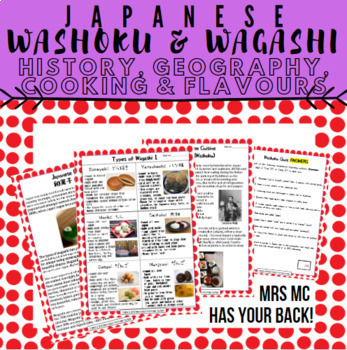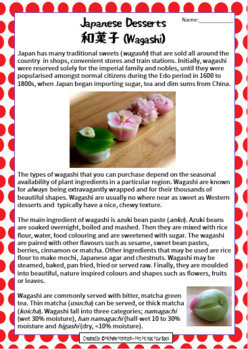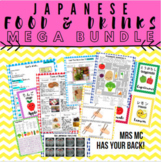Japanese Food: Sweets, Wagashi, Traditional Foods,Washoku, Literacy, Quiz
- PDF
Also included in
- This self-paced, Japanese unit teaches students to describe foods through reading and writing tasks, particles practice, flashcards, crosswords, find a words, match-up activities, labelling activities, literacy articles and cut out activities. Suitable as distance ed take-home bundle for students wiPrice $39.99Original Price $56.93Save $16.94
Description
This 6 page literacy activity introduces students to the development of washoku (Japanese traditional cuisine) and wagashi (Japanese traditional sweets). This touches on Japan's history and trading with China and Korea, westernisation during the Meiji Restoration, geographical advantages, the importance of technological advancements in Japan and the cultural impacts of these. 12 common wagashi are covered, these could be laminated for classroom display, as a lesson hook/warm-up, or for use on cultural cooking days. This also covers the Tsukiji fish market and the importance of seafood as a staple protein. It also has two sets of short answer questions and two sets of 10 quick true/false questions, along with modelled responses.
Included:
- Introduction to washoku (3 page literacy activity)
- History of washoku due to Chinese influence of religion and politics (westernisation by Meiji Restoration)
- Signature cooking methods
- Signature flavour profiles
- The importance of seasonality and the effects of Japan’s geographical location
- Why seafood is a major component of the Japanese diet
- The Tsukiji fish market
- Typical washoku dining layout and components
- Washoku quiz (1 page, short answer)
- Washoku quiz (10 true/false questions)
- Introduction to wagashi (3 page literacy activity)
- History of wagashi due to Chinese influence in the Edo period
- Core ingredients and preparation of wagashi
- Types of wagashi 1 & 2 (12 common wagashi are described and pictured) – could be printed as display cards for cultural days/ classroom display. Wagashi covered are dorayaki, yatsuhashi, mochi, daifuku, dango, manjyuu, youkan, monaka, shiruko, kudzu mochi, anmitu and botamochi.
- Wagashi quiz (1 page, short answer)
- Wagashi quiz (10 true/false questions)
- Answers included
You may also like some of my products in my TPT store:
- 27 Japanese Food Drink Flavor Meal Times Utensils Find A Words Katakana Hiragana
- >400 Japanese Food & Drinks Flashcards Bunting Snap Memory Phrases Cards
- Japanese Time Mega Bundle: 134 activities
- Japanese Describing Hobbies Verbs Time Grammar Bundle Distance Learning
- Japanese Conjugating Verbs to Stem and Dictionary Form Distance Learning
- Japanese Describing Body Parts Grammar Bundle Distance Learning
- Hiragana MEGA Find a Word: Identifying 'i' Adjectives Bundle
- Hiragana Alphabet Bunting with Combination Sounds and Romaji
- Katakana Alphabet Bunting / Flashcards with Combination Sounds and Romaji
- Hiragana Find a Word: Identifying 'na' Adjectives Full
Having difficulty with a file?
If you have any problems with opening or using the file, or find any typos, please click on the Ask a Question tab so I can amend this. You can also visit the FAQ section, submit a help ticket, check the Q&A tab before leaving feedback.
Get TPT credit:
Go to your My Purchases page (log in first) and click on Provide Feedback to leave me a rating and feedback. TPT rewards you with free credits that you can redeem for future purchases!
Copyright © Mrs Mc Has Your Back!
All rights reserved by the author.
Permission to copy for single classroom use only.
Not for public display and/or reproduction.
Please purchase additional licenses if you intend to share this product.






